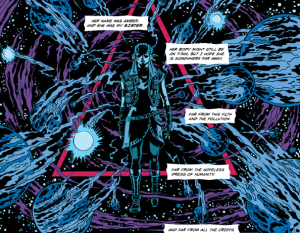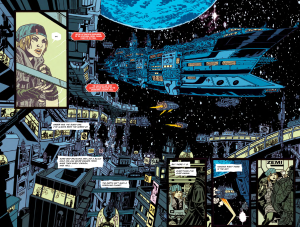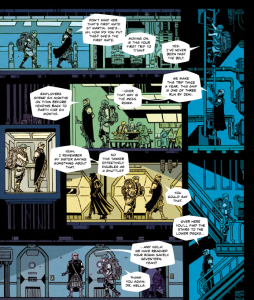I like a good used future. Maybe it’s the cynic in me, but any aesthetic where things look a little more dented and run-down, a little more like regular human beings actually live and work there? I’m there. That’s real for me. There’s a certain beauty to a future with some grit under its fingernails, and not “grit” (neon-soaked streets and perpetually-raining cities full of morally-ambiguous types) like we’re so used to in science fiction. No, give me the blue-collar space trucking of Alien, the snarky ice haulers of The Expanse, and the barely held together ships of Firefly and Serenity any day.
Which brings me to Southern Cross from Image Comics. My first impression of the comic, the latest from Becky Cloonan (Gotham Academy, Killjoys, Demo) and Andy Belanger (Black Church, Kill Shakespeare), was of a future with some grit to it. A future where things feel like they’re actually put to use. An aesthetic I love unapologetically. It also helps that it’s an intriguing first issue, one that asks a great deal of questions and sets up a lot of interesting plot threads that I can only hope are continued throughout the rest of the series. I have to say I’m looking forward to more of what Cloonan and Belanger come up with.
But I’m getting a little ahead of myself. So allow me to back up a little:
Alex Braith has a lot of reasons to be annoyed. She has a record on Earth, she’s stuck for five days on a tanker where everyone seems to have a chip on their shoulder and something to hide, and her sister died on Titan under mysterious circumstances. All she wants to do is get to Titan, collect her sister Amber’s effects, and get some answers for why her sister wound up dead on the Zemi Corporation’s rig despite having a fairly danger-free desk job. If only it were that easy.
But of course it isn’t. Because Alex’s cabin-mate seems a little too friendly. Because the ship’s crew are just as rough around the edges as Alex is herself. Because something on the ship seems to be calling out to her. Because the guy across the hall seems all too eager to wedge his way into Alex’s life– literally. And things like trusting no one and keeping one’s head down are a lot harder when you’re confined on a tanker like the Southern Cross for its five-day voyage to the Titan refinery near Jupiter. Especially when everyone seems to know more, much more, than they let on about Alex’s sister Amber.
Self-admitted screw-up as she may be, though, Alex Braith is definitely not a pushover, and it’ll take more than all that to keep her down. Hopefully.
So first, allow me to just commend the creators on their use of space in their Mise-en-scène. I think one of my favorite pages in the book is the two-page spread of the space dock, a layout that feels suitably vast and allows the ships to be massive in scale, hovering above a futuristic city.
On the other hand, the panel layout in a scene a few pages later makes it easy to follow as two characters wander through the claustrophobic corridors of the Southern Cross, each panel representing another dimly-lit corridor or elevator or stairwell or access shaft. And the panel layout actually mirrors the use of space well, with tight-focused smaller panels for the quarters scenes, but expanding to vast full-page dimensions for the shots of the ship and the space surrounding it.
Another thing I really enjoy about the book is that while the characters might be a little too prickly for my tastes sometimes, they at least feel alive. The characters feel real, from the captain who spends most of his time in the engine room because he feels like the engines “talk” to him, to the heroine who spends a lot of her internal monologue alternately angry at herself and angry at everyone around her (whether they deserve it or not), to minor characters who manage to have a whole life story in a few lines of dialogue. And, while this is something I should probably stop praising people for because it should come second-nature, the dialogue all feels natural. Yes, these people strike me as not having much middle ground between “friendly but with an ulterior motive” and “kind of unfriendly but with no ulterior motives”, but they talk like people. Within their movements they act like people. In short, they feel like people should feel, and I like when authors treat their characters enough like humans that it works.
However, in the interest of fairness, I do have a quibble or two about the dialogue. Namely, the amount of exposition in it. While the majority of the expository dialogue is handled well and feels natural, Alex’s internal monologue feels like more of a way to fill in narrative gaps. It occasionally functions the same way bad voice-over does in movies, either telling us things we find out later on or things that should be obvious from the scene around Alex. In particular, I felt that while the opening narration and conversation with the guard at the security checkpoint were somewhat vital for introducing the character, it would have been better to find a way that involved less exposition, or at the very least, less text boxes. And it wouldn’t be as glaring were it not handled so well in the rest of the issue.
But a few weird moments with text boxes should not and do not sink a very promising first issue of Southern Cross. And it is very promising. It’s an excellent used-future mystery with a gritty aesthetic, a tough and intriguing heroine, and what look to be some very interesting twists and turns in the near future involving both the passengers and the ship itself. I wholly recommend reading this one, and I’m definitely looking forward to more issues of Southern Cross in the future.
Disclosure: The reviewer received a PDF review copy of Southern Cross Issue 1.







